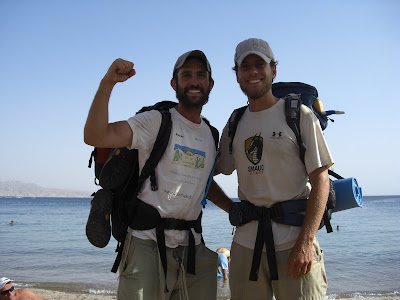
To make up for the one and a half days we skipped going forward to Arad, we walked backwards in the direction of Meitar. The first site of interest we hit was Tel Arad.
Tel Arad is located west of the Dead Sea in an area surrounded by mountain ridges. The site is divided into a lower city and an upper hill which holds the only ever discovered 'House of HaShem' in the land of Israel.
The lower area was first settled during the Chalcolithic period, around 4000 BCE. Excavations at the site have unearthed an extensive Bronze Age Canaanite settlement which was in use until approximately 2650 BCE. The site was then apparently deserted for over 1500 years until resettled in the Israelite period from the 11th century BCE onwards, initially as an unwalled piece of land cut off as an official or sacred domain was established on the upper hill, and then later as a garrison-town known as 'The Citadel'.
The citadel and sanctuary were constructed in the time of King David and Solomon. Artifacts found within the sanctuary of the citadel mostly spoke concerning offerings of oil, wine, wheat brought there by numerous people from David and Solomon's time and throughout the reign of the kings of Judah. In the Persian, Maccabean, Roman, and early Mohammadean eras locals continued to transport these items to the sacred precinct of the upper hill.

During the reign of the kings of Judah the citadel was periodically refortified, remodeled and rebuilt upon one another a number of times, until ultimately it was destroyed between 597 BCE and 577 BCE whilst Jerusalem was under siege from the Babylonian Nebuchadnezzar. Among the most fascinating artifacts unearthed from this time are ostraca from the mid-7th century BCE that refered to this citadel as the House of HaShem.
Habitation of Tel Arad and the upper citadel did not end with the Babylonians. In fact, during the Persian period (5th - 4th centuries BCE) almost a hundred ostracon and pottery were written in Aramaic and were mostly accounts of locals that brought oil, wine, wheat, and etc to the upper hill.
Several citadels were built upon one another and existed in the Hellenistic and Roman periods. King Herod even reconstructed the lower city for the purpose of making bread. The site lasted til the Romans destroyed Jerusalem and completely expelled the 'circumcised' in 135 AD. Tel Arad laid in ruins for 500 years until the Islamic period in which the former Roman citadel was rebuilt and remodeled by some prosperous clan in the area at the time and functioned for 200 years until around 861AD when there was a breakdown of central authority and a period of widespread rebellion whereupon the citadel was destroyed.

Brandon and I went off ahead of the other three and managed to lose our way at a tricky trail marker. We went way off the trail only to stumble upon a herd of sheep with no shepherd in sight.
And oh yeah, and a pack of guard dogs.
Brandon had warned me about Bedouin dogs, having basically been attacked by 20 of them a few months ago on a hike. As soon as they saw us approaching they began snarling and fanned out to surround us. They kept getting closer and Brandon and I waved our hiking poles and threw warning shot rocks. Eventually Brandon connected with a rock to the face and they left us alone. My heart was racing for about an hour afterwards.

The next bit of us getting lost was far more pleasant as we stumbled upon the Bedouin village of Djirat, receiving lemonade from a kind woman and an impromptu tour of caves used by hermits over 200 years ago. According to the tour, Djirat was an important stopover for Abraham on his journey from Hebron to Beer Sheva on his way to Egypt. Today they offer Bedouin feasts and tours. The man kindly gave us some za'atar (a spice like oregano) and sent us in the right direction.


Our stop for the night was Meitar Forest, where we slept on a beautiful ridge with a great view of the sunset.

-Jeremy











































